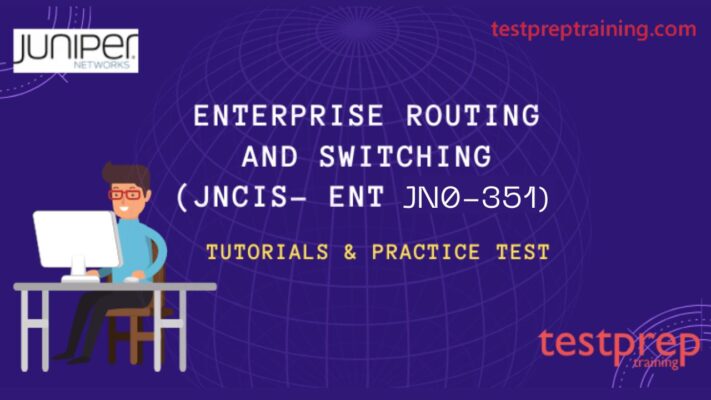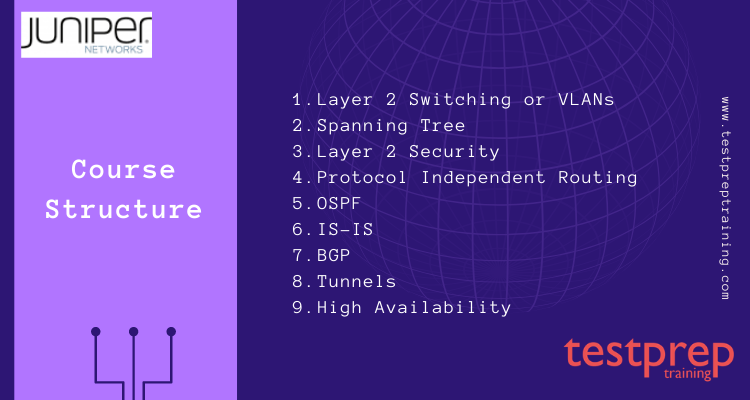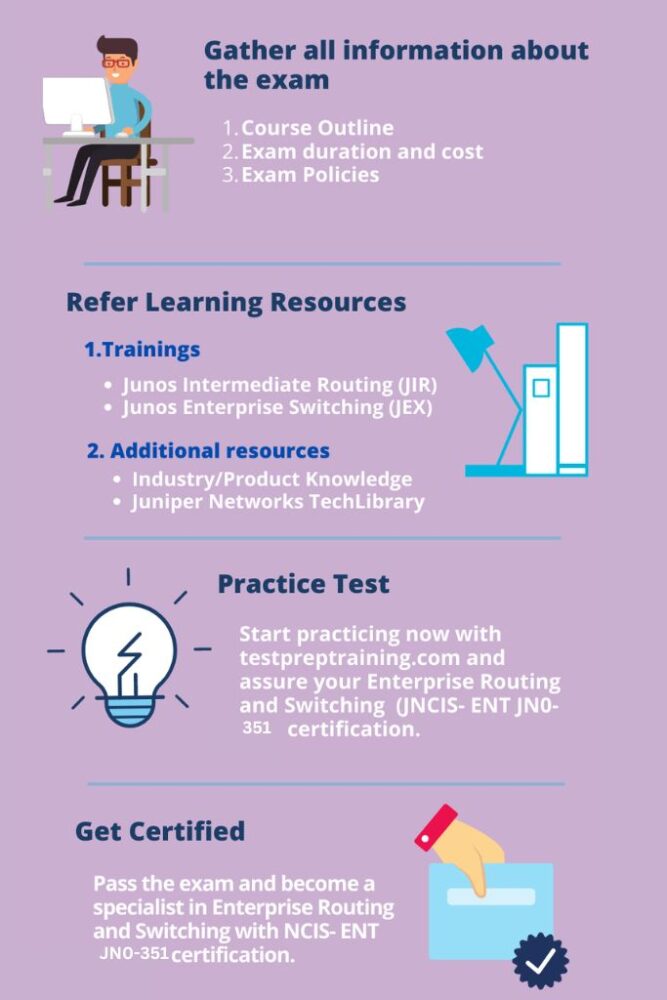JNCIS-ENT JN0-351

The Juniper Networks Certification Program (JNCP) Enterprise Routing and Switching (JNCIS- ENT JN0-351) track is designed to allow participants to exhibit their competence with advanced data center technologies and related configuration and troubleshooting skills. Successful candidates are assumed to have advanced-level knowledge of the Junos OS used in a data center environment.
Who should take the exam?
The exam is designed for networking professionals who are experienced with beginner to intermediate knowledge of routing and switching implementations in Junos. The certification exam will verify the candidate’s basic understanding of routing and switching technologies and it’s related platform configuration and troubleshooting skills.
Exam Prerequisites
Candidates are required to pass the JNCIA-Junos certification exam before starting with Enterprise Routing and Switching (JNCIS- ENT JN0-351) certification exam.
Exam Details
- Exam Name: Enterprise Routing and Switching, Specialist (JNCIS-ENT)
- Exam Code: JN0-351
- Exam Type: Written exam
- Exam Provider: Administered by Pearson VUE
- Exam length: 90 minutes
- Number of Questions: 65
- Pass Score: Pass/fail status is available immediately
However, the JNCIS-ENT JN0-351 exam questions will be in multiple-choice format.
For More Details visit: JNCIS-ENT JN0-351 FAQ
JNCIS-ENT JN0-351 Course Structure
A brief course outline for the JNCIS-ENT JN0-351 course is provided below:

1. Layer 2 Switching or VLANs
1.1 Identify the concepts, operation, or functionality of Layer 2 switching for the Junos OS
- Bridging components (Juniper Documentation: Bridging and VLANs)
- Frame processing
1.2 Describe the concepts, benefits, or functionality of VLANs
- Ports (Juniper Documentation: Ethernet Port VLANs in Switching Mode on Security Devices)
- Tagging (Juniper Documentation: Configuring VLAN Tagging, VLAN-tagging)
- Native VLANs and voice VLANs (Juniper Documentation: native-VLAN-id, Configuring the Native VLAN Identifier, VoIP on EX Series Switches)
- Inter-VLAN routing
1.3 Demonstrate knowledge how to configure, monitor or troubleshoot Layer 2 switching or VLANs
- Interfaces and ports (Juniper Documentation: Configuring a Layer 2 Virtual Switch with a Layer 2 Trunk Port)
- VLANs (Juniper Documentation: Ethernet Switching User Guide)
- Inter-VLAN Routing
2. Spanning Tree
2.1 Describe the concepts, benefits, operation, or functionality of the Spanning Tree Protocol
- STP and RSTP concepts (Juniper Documentation: Understanding RSTP, Overview of Spanning-Tree Protocols)
- Port roles and states (Juniper Documentation: Rapid Spanning Tree Protocol Port States and Port Roles, Spanning-Tree Protocol Overview)
- BPDUs (Juniper Documentation: BPDU Protection for Spanning-Tree Protocols)
- Convergence and reconvergence (Juniper Documentation: Monitoring and Troubleshooting Spanning Tree Protocols, Configuring Faster Convergence and Improving Network Stability with RSTP)
2.2 Demonstrate knowledge how to configure, monitor, or troubleshoot STP and RSTP
- STP (Juniper Documentation: Configuring STP Protocol, Monitoring and Troubleshooting Spanning Tree Protocols)
- RSTP (Juniper Documentation: Configuring RSTP Protocol, Monitoring and Troubleshooting Spanning Tree Protocols)
3. Layer 2 Security
3.1.Identify the concepts, benefits or operation of various Layer 2 protection or security features
- BPDU, loop, or root protection (Juniper Documentation: Understanding Root Protection for STP, RSTP, and MSTP, BPDU Protection for Spanning-Tree Protocols, Loop Protection for Spanning-Tree Protocols)
- Port security, including MAC limiting, DHCP snooping, Dynamic ARP inspection (DAI) or IP source guard (Juniper Documentation: Overview of Port Security, mac-limit (Access Port Security), Understanding DHCP Snooping (ELS), Configuring IP Source Guard and Dynamic ARP Inspection)
- MACsec (Juniper Documentation: Understanding Media Access Control Security (MACsec))
- Storm control (Juniper Documentation: Understanding Storm Control)
3.2.Identify the concepts, benefits or operation of Layer 2 firewall filters
- Filter types (Juniper Documentation: Firewall Filters for EX Series Switches Overview)
- Processing order (Juniper Documentation: Understanding Firewall Filter Processing Points)
- Match criteria and actions (Juniper Documentation: Firewall Filter Match Conditions, Actions, and Action Modifiers, Firewall Filter Match Conditions for Layer 2 Bridging Traffic)
3.3.Demonstrate knowledge how to configure, monitor, or troubleshoot Layer 2 security
- Protection
- Port security (Juniper Documentation: Port Security Overview)
- Storm control (Juniper Documentation: Understanding Storm Control)
- Firewall filter configuration and application (Juniper Documentation: Configuring Firewall Filters (CLI Procedure), Configuring Firewall Filters for Port, VLAN, and Router Traffic on EX Series Switches)
4. Protocol Independent Routing
4.1.Identify the concepts, operation or functionality of various protocol-independent routing components
- Static, aggregate, and generated routes (Juniper Documentation: Understanding Route Aggregation, policy (Aggregate and Generated Routes))
- Martian addresses (Juniper Documentation: Understanding Martian Addresses)
- Routing instances, including RIB groups (Juniper Documentation: Understanding RIB Groups, Configuring Junos OS Routing Tables)
- Load balancing
- Filter-based forwarding (Juniper Documentation: Filter-Based Forwarding Overview)
4.2.Demonstrate knowledge how to configure, monitor, or troubleshoot various protocol-independent routing components
- Static, aggregate, and generated routes (Juniper Documentation: Understanding Route Aggregation)
- Load balancing
- Filter-based forwarding (Juniper Documentation: Filter-Based Forwarding Overview)
5. OSPF
5.1.Describe the concepts, operation or functionality of OSPF
- Link-state database (Juniper Documentation: OSPF Overview, show OSPF database)
- OSPF packet types
- Router ID (Juniper Documentation: Configuring OSPF Designated Routers, router-id)
- Adjacencies and neighbors (Juniper Documentation: Verify OSPF Neighbors)
- Designated router (DR) and backup designated router (BDR) (Juniper Documentation: Configuring OSPF Designated Routers)
- OSPF area and router types (Juniper Documentation: Configuring OSPF Areas)
- Realms (Juniper Documentation: realm)
- Link-state advertisement (LSA) packet types
5.2.Demonstrate knowledge how to configure, monitor or troubleshoot OSPF
- Areas, interfaces, and neighbors (Juniper Documentation: Verifying and Monitoring OSPF Configuration, Configuring OSPF Interfaces, Configuring OSPF Areas)
- Additional basic options
- Routing policy application (Juniper Documentation: Configuring OSPF Routing Policy)
- Troubleshooting tools (e.g., ping, traceroute, trace options, show commands, logging) (Juniper Documentation: Troubleshooting Network Issues, Verifying and Monitoring OSPF Configuration)
6. IS-IS
6.1.Describe the concepts, operation or functionality of IS-IS
- Link-state database (Juniper Documentation: IS-IS Overview)
- IS-IS PDUs (Juniper Documentation: Analyzing IS-IS Link-State PDUs in Detail)
- TLVs (Juniper Documentation: IS-IS Extensions to Support Traffic Engineering)
- Adjacencies and neighbors (Juniper Documentation: Displaying the Status of IS-IS Adjacencies)
- Levels and areas (Juniper Documentation: Understanding IS-IS Areas to Divide an Autonomous System into Smaller Groups, level (Global IS-IS))
- Designated intermediate system (DIS) (Juniper Documentation: Understanding IS-IS Designated Routers, level (IS-IS Interfaces))
- Metrics (Juniper Documentation: metric (Protocols IS-IS))
6.2.Demonstrate knowledge of how to configure, monitor or troubleshoot IS-IS
- Levels, interfaces, and adjacencies (Juniper Documentation: Verifying the IS-IS Configuration on a Router in a Network, Configuring IS-IS)
- Additional basic options
- Routing policy application (Juniper Documentation: Configuring a Routing Policy to Prioritize IS-IS Routes)
- Troubleshooting tools (e.g., ping, traceroute, trace options, show commands, logging)
7. BGP
7.1.Describe the concepts, operation or functionality of BGP
- BGP basic operation (Juniper Documentation: BGP Overview, BGP Configuration Overview)
- BGP message types (Juniper Documentation: BGP Error Messages)
- Attributes
- Route/path selection process (Juniper Documentation: Understanding BGP Path Selection)
- Internal and external BGP (IBGP and EBGP) functionality and interaction (Juniper Documentation: BGP Route Reflectors)
7.2.Demonstrate knowledge of how to configure, monitor, or troubleshoot BGP
- Groups and peers (Juniper Documentation: group (Protocols BGP), BGP Peering Sessions)
- Additional basic options
- Routing policy application (Juniper Documentation: Basic BGP Routing Policies)
- Troubleshooting tools (e.g., ping, traceroute,trace options, show commands, logging) (Juniper Documentation: Troubleshooting BGP Sessions)
8. Tunnels
8.1.Identify the concepts, requirements or functionality of IP tunneling
- Tunneling applications and considerations (Juniper Documentation: Understanding Dynamic IP Tunnels)
- GRE/UDP (Juniper Documentation: Generic Routing Encapsulation (GRE), Configuring GRE Tunnel Interfaces)
- IP-IP
8.2.Demonstrate knowledge of how to configure, monitor or troubleshoot IP tunnels
- GRE/UDP (Juniper Documentation: Configuring GRE Tunnel Interfaces, Generic Routing Encapsulation (GRE))
- IP-IP (Juniper Documentation: Configuring IP Monitoring on SRX Series Devices)
- Troubleshooting tools (e.g., ping, traceroute, trace options, show commands, logging) (Juniper Documentation: Using the ping Command)
9. High Availability
9.1.Identify the concepts, benefits, applications or requirements for high availability in a Junos OS environment
- Link aggregation groups (LAG) (Juniper Documentation: Understanding Link Aggregation and Link Aggregation Control Protocol)
- Redundant trunk groups (RTG) (Juniper Documentation: Redundant Trunk Groups, Configuring Redundant Trunk Groups)
- Virtual Chassis (Juniper Documentation: Virtual Chassis Overview for Switches)
- Graceful restart (GR) (Juniper Documentation: Graceful Restart Concepts)
- Graceful Routing Engine switchover (GRES) (Juniper Documentation: Understanding Graceful Routing Engine Switchover, Configuring Graceful Routing Engine Switchover)
- Nonstop active routing (NSR) (Juniper Documentation: Nonstop Active Routing Concepts)
- Nonstop bridging (NSB) (Juniper Documentation: Understanding Nonstop Bridging on EX Series Switches, Configuring Nonstop Bridging on Switches)
- Bidirectional Forwarding Detection (BFD) (Juniper Documentation: Bidirectional Forwarding Detection (BFD) for MPLS)
- Virtual Router Redundancy Protocol (VRRP) (Juniper Documentation: Understanding VRRP)
- Unified In-Service Software Upgrade (ISSU) (Juniper Documentation: Understanding In-Service Software Upgrade (ISSU))
9.2.Demonstrate knowledge of how to configure, monitor, or troubleshoot high availability components
- LAG and RTG (Juniper Documentation: Redundant Trunk Groups)
- Virtual Chassis (Juniper Documentation: Understanding Virtual Chassis Components)
- GR, GRES, NSB, and NSR (Juniper Documentation: Understanding High Availability Features on Juniper Networks Routers, High Availability Features for EX Series Switches Overview)
- VRRP
- ISSU (Juniper Documentation: Unified ISSU System Requirements)
- Troubleshooting tools (e.g., trace options, show commands, logging)
Juniper JNCIS-ENT JN0-351 Study Guide

Learning resources: JNCIS-ENT JN0-351
Refer the following JNCIS-ENT JN0-351 training resources to gain a better understanding about this course:
1.Training
1.1. Junos Intermediate Routing (JIR)
Junos Intermediate Routing (JIR) is a two-day course that will provide you intermediate routing knowledge and configuration examples. The course includes an overview of protocol-independent routing features, load balancing and filter-based forwarding, OSPF, BGP, IP tunneling, and high availability (HA) features. with demonstrations and hands-on labs, you will gain experience in configuring and monitoring the Junos OS and monitoring device operations. This course is based on Junos OS Release 18.2R1.9. and uses Juniper Networks vSRX Series Services Gateways for the hands-on component, but the lab environment does not preclude the course from being applicable to other Juniper hardware platforms running the Junos OS.
1.2. Junos Enterprise Switching (JEX)
This course is based on Junos OS Release 20.1R1.11 and is a two-day course that will provide you with intermediate switching knowledge and configuration examples using Junos Enhanced Layer 2 Software. Junos Enterprise Switching (JEX) course uses Juniper Networks EX4300 Series Ethernet Switches for the hands-on components, but the lab environment does not preclude the course from being applicable to other Juniper hardware platforms running the Junos OS. The course also includes an overview of switching concepts and operations, virtual LANs (VLANs), the Spanning Tree Protocol (STP), port and device security features, and high availability (HA) features. This is an interactive and practical course as it provides demonstrations and hands-on labs which will help you gain experience in configuring and monitoring the Junos OS and in monitoring device operations.
2. Additional resources
2.1. Industry/Product Knowledge
2.2. Juniper Networks TechLibrary
As the name suggests, this is a Network Techlibrary where you can find near about each and every type of information related to Juniper certification. This includes everything ranging from JNCIS-ENT JN0-351 dumps to:
- Product Documentation
- Design Center
- Learning Center
- Tools & Application
- What’s New
Books

Books can provide an advantage to learn and understand things more accurately. For the Enterprise Routing and Switching (JNCIS- ENT JN0-351) exam, there are various Books available which you can find online or in libraries. Some of the books are as follows:

- Junos Enterprise Routing 2e PaperbackJunos
- JUNOS Enterprise Switching: A Practical Guide to Junos Switches and Certification Paperback
Join Community
One thing that will be beneficial during the exam preparation time is to join communities and study groups. These groups will help you to stay connected with your peers who are on the same pathway as yours. Moreover, here you can start any discussion about the exam-related queries at any time. By doing so, you will get the best possible answer to your query as the members of such communities are both experienced professionals and new learners.
Evaluate your self with Practice Tests
After you are done with your preparation it is always recommenced to take practice tests. JNCIS-ENT JN0-351 practice tests are the best source of self-assessment as it helps you to identify your weak areas which need further improvement. It is always better to make mistakes in practice sessions rather than committing blunders in the actual exam. You can enroll for testpreptraining JNCIS-ENT JN0-351 practice test as it is based upon the actual exam pattern and is time-bound similar to the JNCIS-ENT JN0-351 certification exam. So, take the JNCIS-ENT JN0-351 sample questions for practice and assure your success in the exam.


